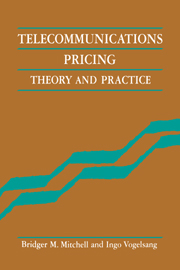Book contents
- Frontmatter
- Contents
- List of figures
- List of tables
- Acknowledgments
- I PRICING AND TELECOMMUNICATIONS
- II RECENT DEVELOPMENTS IN THE NORMATIVE ECONOMIC THEORY OF TARIFFS
- III TELEPHONE RATE STRUCTURES IN THE UNITED STATES
- 7 Regulation and US retail rates
- 8 Optional calling plans
- 9 Business bulk-rate tariffs
- 10 Pricing of carrier services
- 11 Social tariffs
- IV SYNTHESIS
- A US telephone price indexes
- Bibliography
- Index
- Selected list of RAND books
7 - Regulation and US retail rates
Published online by Cambridge University Press: 28 October 2009
- Frontmatter
- Contents
- List of figures
- List of tables
- Acknowledgments
- I PRICING AND TELECOMMUNICATIONS
- II RECENT DEVELOPMENTS IN THE NORMATIVE ECONOMIC THEORY OF TARIFFS
- III TELEPHONE RATE STRUCTURES IN THE UNITED STATES
- 7 Regulation and US retail rates
- 8 Optional calling plans
- 9 Business bulk-rate tariffs
- 10 Pricing of carrier services
- 11 Social tariffs
- IV SYNTHESIS
- A US telephone price indexes
- Bibliography
- Index
- Selected list of RAND books
Summary
In Part II of this book we have reviewed and synthesized the theory of optimal pricing to the extent that we believe it is applicable to telecommunications services. In Part III we will survey innovative US practice in setting telecommunications tariffs.
This chapter links theory and practice. First, in Section 7.1 we establish linkages between theoreticaly optimal prices and their implementation in the regulatory process. Next, in Section 7.2 we survey the basic retail rate structures in effect for local and long-distance telephone services. (Optional rates at the retail level are covered in detail in the following chapter, and rate structures for bulk purchase are taken up in Chapter 9.) Finally, in Section 7.3, we describe price caps as a recent regulatory innovation that will move regulated rates away from fully distributed-cost (FDC) pricing rules and possibly toward efficient rate structures.
The impact of regulation on rate setting
The implementation problem
As indicated in Chapter 1, pricing theory and practice may influence each other in various ways. In particular, there are several reasons why practical solutions may differ from theoretically prescribed tariffs. Three such reasons appear to be particularly relevant:
The real world is much more complex than the economist's models. The implications of such complexity for pricing were outlined in Sections 5.9 and 6.5.
Policymakers may have objectives and constraints that differ from those assumed by economic theorists. Since this book is about optimal tariffs in a normative sense, we really have little to say about this second reason. Convincing objectives and constraints should, in principle, be open to economic modeling. In a positive sense, regulators may be found to have selfish or inconsistent objectives, partly in response to competing interest groups.
- Type
- Chapter
- Information
- Telecommunications PricingTheory and Practice, pp. 149 - 175Publisher: Cambridge University PressPrint publication year: 1991



